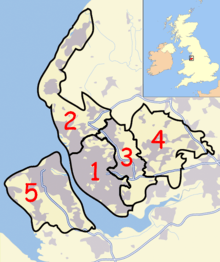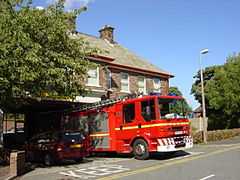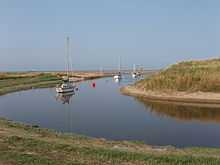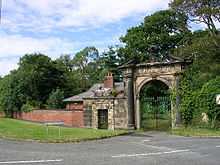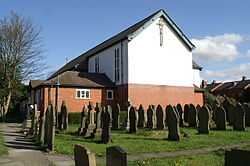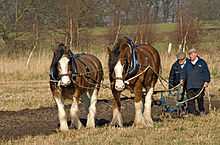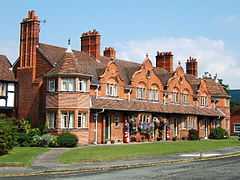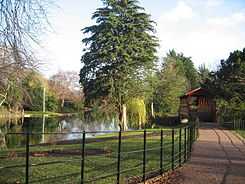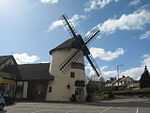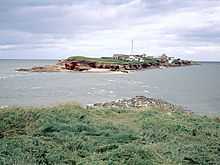Civil parishes in Merseyside
A civil parish is a country subdivision, forming the lowest unit of local government in England. There are 23 civil parishes in the ceremonial county of Merseyside, most of the county being unparished; Liverpool and Wirral are completely unparished. At the 2001 census, there were 177,663 people living in the 23 parishes, accounting for 13.0 per cent of the county's population.
History
Parishes arose from Church of England divisions, and were originally purely ecclesiastical divisions. Over time they acquired civil administration powers.[1]
The Highways Act 1555 made parishes responsible for the upkeep of roads. Every adult inhabitant of the parish was obliged to work four days a year on the roads, providing their own tools, carts and horses; the work was overseen by an unpaid local appointee, the Surveyor of Highways.[2]
The poor were looked after by the monasteries, until their dissolution. In 1572, magistrates were given power to 'survey the poor' and impose taxes for their relief. This system was made more formal by the Poor Law Act 1601, which made parishes responsible for administering the Poor Law; overseers were appointed to charge a rate to support the poor of the parish.[3] The 19th century saw an increase in the responsibility of parishes, although the Poor Law powers were transferred to Poor Law Unions.[4] The Public Health Act 1872 grouped parishes into Rural Sanitary Districts, based on the Poor Law Unions; these subsequently formed the basis for Rural Districts.[5]
Parishes were run by vestries, meeting annually to appoint officials, and were generally identical to ecclesiastical parishes,[6] although some townships in large parishes administered the Poor Law themselves; under the Divided Parishes and Poor Law Amendment Act 1882, all extra-parochial areas and townships that levied a separate rate became independent civil parishes.[7]
Civil parishes in their modern sense date from the Local Government Act 1894, which abolished vestries; established elected parish councils in all rural parishes with more than 300 electors; grouped rural parishes into Rural Districts; and aligned parish boundaries with county and borough boundaries.[7] Urban civil parishes continued to exist, and were generally coterminous with the Urban District, Municipal Borough or County Borough in which they were situated; many large towns contained a number of parishes, and these were usually merged into one. Parish councils were not formed in urban areas, and the only function of the parish was to elect guardians to Poor Law Unions; with the abolition of the Poor Law system in 1930 the parishes had only a nominal existence.[8]
The Local Government Act 1972 retained civil parishes in rural areas, and many former Urban Districts and Municipal Boroughs that were being abolished, were replaced by new successor parishes; urban areas that were considered too large to be single parishes became unparished areas.[9]
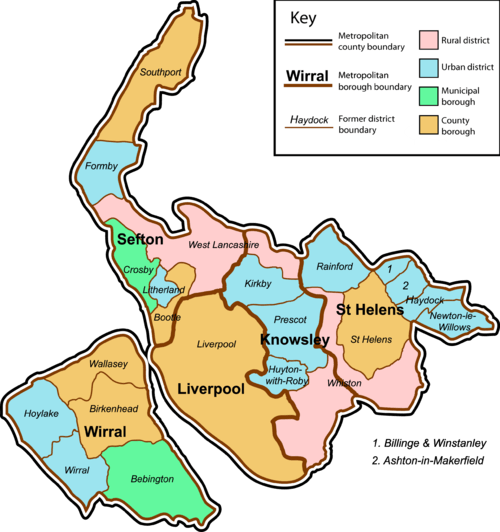
The current position
Recent governments have encouraged the formation of town and parish councils in unparished areas, and the Local Government and Rating Act 1997 gave local residents the right to demand the creation of a new civil parish.[10]
A parish council can become a town council unilaterally, simply by resolution;[9] and a civil parish can also gain city status, but only if that is granted by the Crown.[9] The chairman of a town or city council is called a mayor.[9] The Local Government and Public Involvement in Health Act 2007 introduced alternative names: a parish council can now choose to be called a community; village; or neighbourhood council.[11]
List of civil parishes and unparished areas
See also
References
- ↑ Angus Winchester, 2000, Discovering Parish Boundaries. Shire Publications. Princes Risborough, 96 pages ISBN 978-0-7478-0470-3
- ↑ RAC Foundation : What Went Wrong? British Highway Development Before Motorways Retrieved 2009-08-22
- ↑ The Victorian Web : The Poor Law : Introduction Retrieved 2009-08-22
- ↑ Staffordshire University : Poor Law Unions and Registration Districts Retrieved 2009-08-22
- ↑ A Vision of Britain Through Time : Status Details for Rural Sanitary District Retrieved 2009-08-22
- ↑ Robert Tittler, The Reformation and the Towns in England, 1998, Oxford University Press, 395 pages, ISBN 978-0-19-820718-4
- ↑ 7.0 7.1 Modern British Surnames : Selected Events in the History of Civil Registration and Boundary Changes 1801-1996 Retrieved 2009-08-22
- ↑ Alex MacMorran and T R Colquhoun Dill, The Local Government Act 1894 and the Subsequent Statutes Affecting Parish Councils, 1907, Butterworth and Co, London, 626 pages
- ↑ 9.0 9.1 9.2 9.3 Office of Public Sector Information : Local Government Act 1972 Retrieved 2009-08-22
- ↑ Office of Public Sector Information : Local Government and Rating Act 1997 Retrieved 2009-08-22
- ↑ Office of Public Sector Information : Local Government and Public Involvement in Health Act 2007 Retrieved 2009-08-22
- ↑ 12.0 12.1 12.2 12.3 12.4 12.5 12.6 12.7 12.8 A Vision of Britain Through Time : Whiston Rural District Retrieved 2009-08-23
- ↑ 13.0 13.1 13.2 13.3 13.4 13.5 Office for National Statistics : Census 2001 : Parish Headcounts : Knowsley Retrieved 2009-08-24
- ↑ A Vision of Britain Through Time : Huyton with Roby Urban District Retrieved 2009-08-23
- ↑ Office for National Statistics : Census 2001 : Table KS01 : Usual Resident Population Longview; Page Moss; Prescot East (part); Prescot West (part); Princess; Roby; St Gabriels; St Michaels; and Swanside wards. Retrieved 2009-08-26
- ↑ A Vision of Britain Through Time : Kirkby Urban District Retrieved 2009-08-23
- ↑ Office for National Statistics : Census 2001 : Table KS01 : Usual Resident Population Cherryfield; Kirkby Central; Northwood; Park; Tower Hill; and Whitefield wards. Retrieved 2009-08-26
- ↑ A Vision of Britain Through Time : Prescot Urban District Retrieved 2009-08-23
- ↑ A Vision of Britain Through Time : Liverpool County Borough Retrieved 2009-08-23
- ↑ Office for National Statistics : Census 2001 : Table KS01 : Usual Resident Population Abercromby; Aigburth; Allerton; Anfield; Arundel; Breckfield; Broadgreen; Childwall; Church; Clubmoor; County; Croxteth; Dingle; Dovecot; Everton; Fazakerley; Gillmoss; Granby; Grassendale; Kensington; Melrose; Netherley; Old Swan; Picton; Pirrie; Smithdown; Speke; St Mary's; Tuebrook; Valley; Vauxhall; Warbreck; and Woolton wards. Retrieved 2009-08-26
- ↑ 21.0 21.1 21.2 21.3 21.4 21.5 21.6 21.7 A Vision of Britain Through Time : West Lancashire Rural District Retrieved 2009-08-23
- ↑ 22.0 22.1 22.2 22.3 22.4 22.5 22.6 22.7 22.8 Office for National Statistics : Office for National Statistics : Census 2001 : Parish Headcounts : Sefton Retrieved 2009-08-24
- ↑ A Vision of Britain Through Time : Bootle County Borough Retrieved 2009-08-23
- ↑ Office for National Statistics : Census 2001 : Table KS01 : Usual Resident Population Derby; Linacre; Litherland (part); Netherton and Orrell; and St Oswald wards. Retrieved 2009-08-26
- ↑ 25.0 25.1 A Vision of Britain Through Time : Crosby Municipal Borough Retrieved 2009-08-23
- ↑ Office for National Statistics : Census 2001 : Table KS01 : Usual Resident Population Blundellsands; Church; Manor (part); and Victoria wards. Retrieved 2009-08-26
- ↑ A Vision of Britain Through Time : Formby Urban District Retrieved 2009-08-23
- ↑ Office of the Deputy Prime Minister : Bulletin of Changes to Local Authority Areas and Names in England : The Sefton (Parishes) Order 2003 Retrieved 23 August 2009
- ↑ Office for National Statistics : Census 2001 : Table KS01 : Usual Resident Population Harington; and Ravenmeols (part) wards. Retrieved 2009-08-26
- ↑ A Vision of Britain Through Time : Litherland Urban District Retrieved 2009-08-23
- ↑ Office for National Statistics : Census 2001 : Table KS01 : Usual Resident Population Ford; and Litherland (part) wards. Retrieved 2009-08-26
- ↑ A Vision of Britain Through Time : Southport County Borough Retrieved 2009-08-23
- ↑ Office for National Statistics : Census 2001 : Table KS01 : Usual Resident Population Ainsdale; Birkdale; Cambridge; Duke's; Kew; Meols; and Norwood wards. Retrieved 2009-08-26
- ↑ A Vision of Britain Through Time : Billinge and Winstanley Urban District Retrieved 2009-08-24
- ↑ 35.0 35.1 35.2 35.3 35.4 35.5 35.6 Office for National Statistics : Census 2001 : Parish Headcounts : St Helens Retrieved 2009-08-24
- ↑ A Vision of Britain Through Time : Haydock Urban District Retrieved 2009-08-24
- ↑ Office for National Statistics : Census 2001 : Table KS01 : Usual Resident Population Blackbrook (part); Broad Oak (part); and Haydock wards. Retrieved 2009-08-26
- ↑ A Vision of Britain Through Time : Newton le Willows Urban District Retrieved 2009-08-24
- ↑ Office for National Statistics : Census 2001 : Table KS01 : Usual Resident Population Earlstown; and Newton wards. Retrieved 2009-08-26
- ↑ A Vision of Britain Through Time : Rainford Urban District Retrieved 2009-08-24
- ↑ A Vision of Britain Through Time : Ashton in Makerfield Urban District Retrieved 2009-08-24
- ↑ A Vision of Britain Through Time : St Helens County Borough Retrieved 2009-08-24
- ↑ Office for National Statistics : Census 2001 : Table KS01 : Usual Resident Population Blackbrook (part); Broad Oak (part); Grange Park; Marshalls Cross; Moss Bank; Parr and Hardshaw; Queen's Park; Sutton and Bold (part); Thatto Heath; West Sutton; and Windle (part) wards. Retrieved 2009-08-26
- ↑ A Vision of Britain Through Time : Bebington Municipal Borough Retrieved 2009-08-24
- ↑ Office for National Statistics : Census 2001 : Table KS01 : Usual Resident Population Bebington; Bromborough; Clatterbridge; and Eastham wards. Retrieved 2009-08-26
- ↑ A Vision of Britain Through Time : Birkenhead County Borough Retrieved 2009-08-24
- ↑ Office for National Statistics : Census 2001 : Table KS01 : Usual Resident Population Bidston; Birkenhead; Claughton; Egerton; Oxton; Prenton (part); Tranmere; and Upton wards. Retrieved 2009-08-26
- ↑ A Vision of Britain Through Time : Wirral Urban District Retrieved 2009-08-24
- ↑ Office for National Statistics : Census 2001 : Table KS01 : Usual Resident Population Heswall; Prenton (part); and Thurstaston (part) wards. Retrieved 2009-08-26
- ↑ A Vision of Britain Through Time : Hoylake Urban District Retrieved 2009-08-24
- ↑ Office for National Statistics : Census 2001 : Table KS01 : Usual Resident Population Hoylake; Royden; and Thurstaston (part) wards. Retrieved 2009-08-26
- ↑ A Vision of Britain Through Time : Wallasey County Borough Retrieved 2009-08-24
- ↑ Office for National Statistics : Census 2001 : Table KS01 : Usual Resident Population Leasowe; Liscard; Moreton; New Brighton; Seacombe; and Wallasey wards. Retrieved 2009-08-26
External links
- Office for National Statistics : Geographical Area Listings
- Knowsley Metropolitan Borough Council : Parish and Town Councils
- Sefton Metropolitan Borough Council : Parish and Town Councils
- St Helens Metropolitan Borough Council : Parish and Town Councils
| ||||||||||||||||||||||
